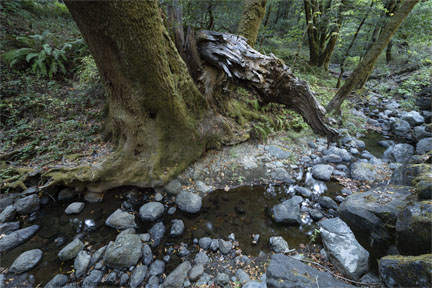Sony FE 12-24mm f/2.8 GM Aperture Series: Big Tree at Bend in Alpine Creek (jaw-dropping focus shift and lens skew)
See Update on Sony A7R IV Lens Mount / Sensor Parallelism.
See my Sony mirrorless wishlist.
I finally got up the energy to get out and do some local shooting*, only to be hugely annoyed at the most bizarre lens performance I’ve seen in a long time, with the Sony FE 12-24mm f/2.8 GM. Hazardous smoke today, and bad yesterday, so I am particularly irritated at having go do redo all my work. Who knows when the smoke will clear out, and I can’t go anywhere in California because of either smoke or national forest closures.
I don’t usually like to publish “bad sample” aperture series, but this one is so whacko that I though it would be useful perspective. This aperture series at 17mm shows one of the most severe and bizarre performances that I’ve ever seen from a lens: massive focus shift sufficient to change the image magnification along with a resoundingly different sharpness on the left side versus the right, presumably a form of lens skew.
Sony FE 12-24mm f/2.8 GM Aperture Series: Big Tree at Bend in Alpine Creek
Images at up to full camera resolution from f/2.8 through f/11.
All signs point to the Sony 12-24/2.8 GM optical design having magnificent potential performance.
UPDATE Oct 5: a second sample now suggests to me that the Sony A7R IV might be the issue, e.g., lens mount / sensor parallelism. So the A7R IV is going into Sony for a checkup. I find it puzzling because it is a brand new sensor installed by Sony a few months after purchase that performed fine for months (e.g. in March and April with the Voigtlander 50mm f/2 APO), and I am unaware of any trauma, even minor, to the camera. However, all samples *do* confirm the tremendous outer-zone peripheral forward focus shift. A slight misalignment combined with that severe a focus shift is really confusing, even to me!
B&H Photo has been kind enough to overnight another sample to me, which I hope will at least be serviceable with only a little lens skew. Maybe not likely, but I’m hoping.
UPDATE: Roy P sent me images from his sample of the 12-24/2.8GM that confirm the pronounced forward focus shift — so strong that even 3 stops of depth of field cannot compensate—absurdly damaging. His lens seems to be OK in terms of lens skew, though only a good near-to-far scene can say for sure.
UPDATE 2: Stephen S sent me an aperture series. He got lucky with what looks to be a symmetric lens sample (minimal lens skew). But his series confirms the same huge outer-zone peripheral forward focus shift, such that even f/8 cannot come close to compensating for—f/8 is much worse than f/2.8, so severe is the shift.
It is now a key task to hope I get a symmetric copy, and if so, to detail how those using the Sony FE 12-24mm f/2.8 GM can obtain high quality (or if it is even possible for a 3D or planar scene), given what looks to be the most outrageous focus shift I have ever seen in a lens in this range.

Sony A7R IV + Sony FE 12-24mm f/2.8 GM @ 17mm
ENV: Alpine Creek, altitude 650 ft / 198 m, 78°F / 25°C
RAW: Enhance Details, LACA corrected
[low-res image for bot]
Mark M writes:
You wrote: "The Sony FE 12-24mm f/2.8 GM optical design looks to have magnificent potential, but it sure looks to me like Sony is incapable of building it to perform anywhere near that….”.
Yet again. Canon, Nikon and Zeiss are great optical houses (each with shortcomings which you have exquisitely detailed for us in your various trenchant reviews).
The hands that touch their best glass operate within a lens manufacturing and assembling culture where QC/QA that has been honed over generations. Sony is a chip design and manufacturing powerhouse—human hands therein touch little for the tolerances be too critical.
Given the competitive pressures that Canon, Nikon, Panasonic and Fuji are placing on the mirrorless segment, one must wonder if the same level of Sony sensor excellence will ever be realized in their lens production efforts. Chips are, relatively speaking, cheap for Sony. Fine glass is very much not.
I would gladly given up a stop of light and shoot the Canon EF 11-24mm f4 L adapted on the R5. It is harder than ever to secure an income from our craft these days. This level of lens under performance is an insult to this reality. I will stick with the Batis Series on my various A7R models and happily consider them them professionally sufficient even with only a 18mm wide to through over a scene.
DIGLOYD: unfortunately, it's an industry wide problem. Some brands are better than others, but on the whole it’s a mess, and zooms are rarely if ever good throughout. It’s doubly frustrating to see the potential, but then have to be thumped hard between the eyes by both lens skew and the most absurd focus shift I’ve seen in a zoom of this kind—when f/9 is worse than f/2.8 that’s a totally unusable lens.
I was going to buy a Sigma 14-24mm f/2.8 DG DN Art after testing it last year, but two more samples both had such obvious trouble on one side of the frame that I abandoned that idea.
Canon is generally excellent BUT while the first sample of the Canon RF 28-70m f/2L was terrific while the 2nd sample had obvious symmetry issues.
Stephen S writes:
I acquired this lens yesterday, have very limited time so far with it. I’ll see if I can confirm your findings.
Any particular settings or workflow you recommend I follow to help you discern any issues with focus shift?
DIGLLOYD: my best reference guide (which needs some more examples) is How to Test a Lens in Making SHarp Images. On my to-do list for that area are a examples of problem lenses.
In brief, when testing for focus shift, you want a good near-to-far subject with good detail throughout. Focus wide open, then shoot an aperture series through f/8. Examine carefully, looking for how the centering of the zone of focus changes. In bad cases, stopping down can increase blur. Focus shift varies within the frame too, e.g. a shift in the center but not in the outer zones, or vice versa. And/or it can be in reverse directions. It’s all part of balancing optical tradeoffs.



























